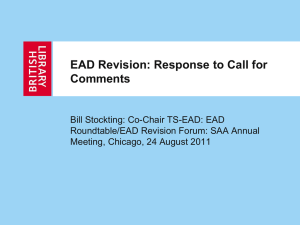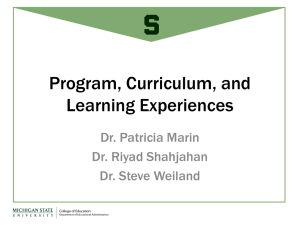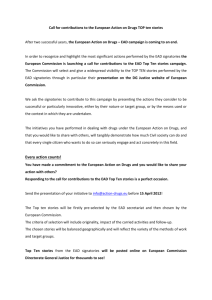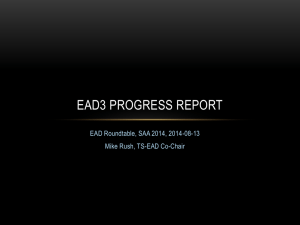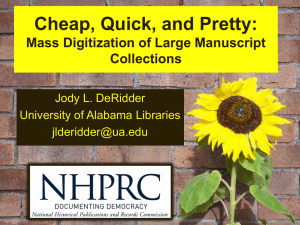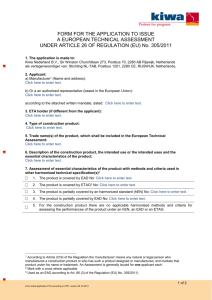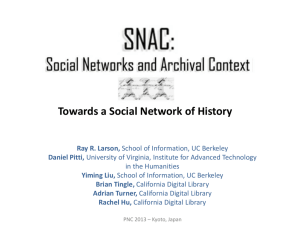UK_ara_dsg_eadsubmission - Society of American Archivists
advertisement
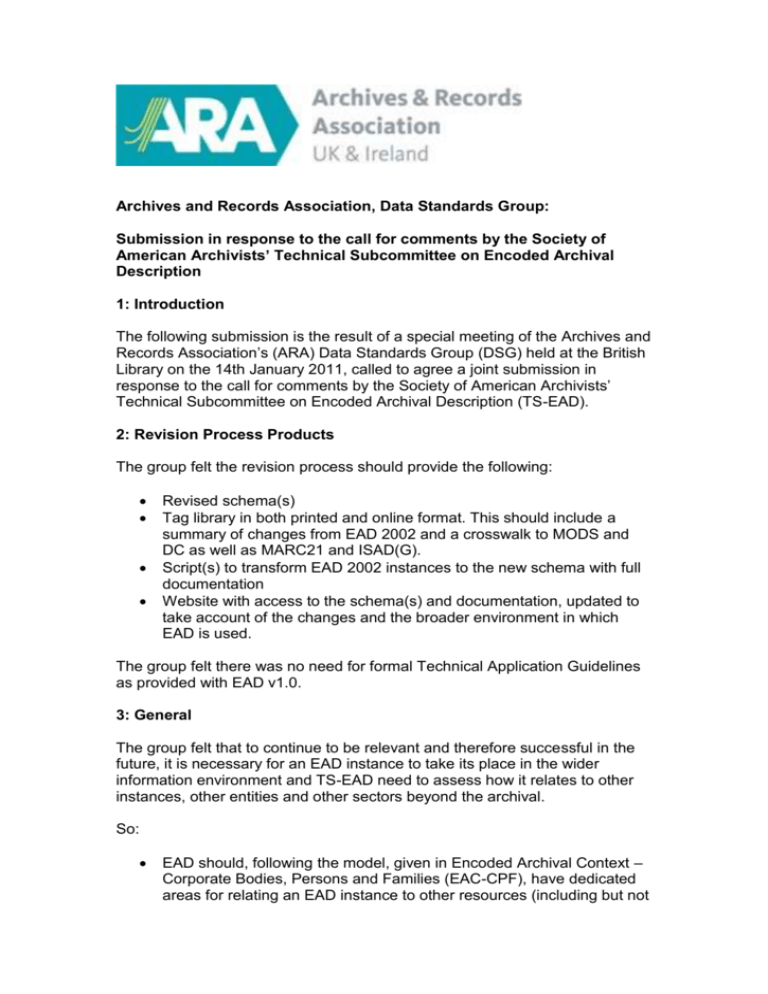
Archives and Records Association, Data Standards Group: Submission in response to the call for comments by the Society of American Archivists’ Technical Subcommittee on Encoded Archival Description 1: Introduction The following submission is the result of a special meeting of the Archives and Records Association’s (ARA) Data Standards Group (DSG) held at the British Library on the 14th January 2011, called to agree a joint submission in response to the call for comments by the Society of American Archivists’ Technical Subcommittee on Encoded Archival Description (TS-EAD). 2: Revision Process Products The group felt the revision process should provide the following: Revised schema(s) Tag library in both printed and online format. This should include a summary of changes from EAD 2002 and a crosswalk to MODS and DC as well as MARC21 and ISAD(G). Script(s) to transform EAD 2002 instances to the new schema with full documentation Website with access to the schema(s) and documentation, updated to take account of the changes and the broader environment in which EAD is used. The group felt there was no need for formal Technical Application Guidelines as provided with EAD v1.0. 3: General The group felt that to continue to be relevant and therefore successful in the future, it is necessary for an EAD instance to take its place in the wider information environment and TS-EAD need to assess how it relates to other instances, other entities and other sectors beyond the archival. So: EAD should, following the model, given in Encoded Archival Context – Corporate Bodies, Persons and Families (EAC-CPF), have dedicated areas for relating an EAD instance to other resources (including but not limited to archives), entities that created (or have any other relationship) to the material described, the functions and activities of which the material described are evidence and possibly the places to which the material relates. EAD should (again following the model in EAC-CPF) allow the insertion of valid data from other XML namespaces. Examples suggested were EAC-CPF, XHTML, KML, MARC21, MODS, and TEI (10: cataloguing). EAD should be made more ‘database friendly’. Experience in the UK has shown that exporting and importing EAD instances out of and into databases is fraught with difficulty and the group, therefore, asks that TS-EAD make the next version of EAD more functional in this respect. In particular, formatting tags should be lost or if this is not possible greatly reduced and made more generic, perhaps along the lines of the model of the <descriptiveNote> tag in EAC-CPF. Thought here should be given to allowing inclusion of HTML tagged data. There should also be fewer opportunities for mixed–content generally. It was felt that EAD should be generally less complex and many of the proposals below have this in mind. Despite the above, it was felt very strongly that it is necessary to continue to allow EAD to be used alone rather than within a more dynamic environment. 4: Hierarchical structure and related tags The group felt that the way the archival hierarchy is currently represented in overly complex and propose that: The <archdesc> tag should simply be a wrapper tag containing the hierarchical components of the description, that is it should not directly hold descriptive elements itself and the highest level of description should be held in a component tag (<c>). The <dsc> tag should be abolished: The current division between the upper level description and the remaining components is felt to represent an out of date paper model for archival data that seems to privilege description at the uppermost level. Such a split is not reflected in ISAD(G) and is, therefore, difficult to teach to UK archivists and also complicates data exchange and transformation. Numbered component tags (<c01> etc) should be abolished. It was felt that the ability to use two tags to represent the same structure again makes data exchange and transformation more complex and is also more difficult to teach as students find it difficult to understand that the component number does not always relate to the same hierarchical level. The Level attribute should be made mandatory 5: Content wrapper tags Noting the deprecation of some wrapper tags in the last revision, the group asks TS-EAD to look at the efficacy of the following elements: <did>: While designed to wrap the ‘core’ elements of description, little use has been found for it in practice and what constitutes the core elements differs in line with national and local standards and practice. The addition of the <abstract> tag in the last revision within the <did> was also seen as unhelpful. It is not used in the UK and its relationship to key descriptive elements such as <title> and <scopecontent> is confused. <physdesc>: It was proposed that the elements within <physdesc> should be available outside it, particularly in the case of the key element <extent>. Consideration should then be given to whether there is a need for a separate tag for physical description as such particularly if elements from other namespaces such as TEI for example may be used (see 3 above) 6: Particular elements <bioghist>: This should remain to hold contextual information about creators to enable users to use EAD alone rather than as part of a system with links to descriptions of creating entities held in EAC-CPF (see 3 above). The group thought, however, that TS-EAD should give some consideration to where contextual information about creation and use of the particular records being described (rather than more general information found in a biographical sketch or administrative history) belongs. Should there be another specific tag for this information or does <bioghist> serve both purposes? <*date>: The date elements in EAD should be able to express ranges, uncertainty, complex dates and normalisation. The model in EAC-CPF would be a good starting point but it should also be possible to capture precise time and time zone information as well. <eadgrp>: The tags relating to EAD Group should be abolished. Rather than grouping separate EAD files in this way, they should be related to each other as related resources as suggested in 3 above <eadheader>: The group felt that the model here should be changed in favour of that of the <control> area found in EAC-CPF which would bring it more into line with the ICA’s description standards. <geogname>: The group felt that the underlying model for spatial information in EAD should be reviewed alongside the purpose of this tag. Something similar to EAC-CPF’s model for <place> (as opposed to place names) might be more suitable. Provision should certainly be made for the addition of geocodes. The model for <placeEntry> in EAC-CPF with attributes for latitude, longitude and altitude is favoured but there must also be the ability to use other national or local systems, such OS Grid References in the UK context. Consideration should also be given for including data from other namespaces such as KML for example. <head>: The group felt that TS-EAD should consider the purpose of this element with a view to deprecation or abolition. <*name>: It should be possible to indicate the parts of person, family and corporate names and possibly place names. The use of the generic <part> tag found in the EAC-CPF <nameEntry> tag was favoured as a model. <table>: Table and related elements should be abolished 7: Additions The group felt that TS-EAD should: Enable the capture of the language and script of names and any other appropriate entities by addition of language attributes Consider how user generated content can be incorporated and acknowledged in EAD instances Victoria Peters, Chair ARA DSG Bill Stockting, British Library 15/2/2011
